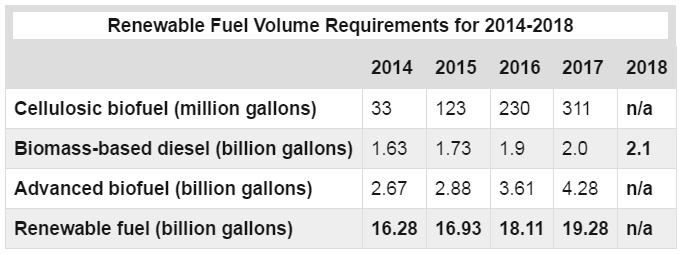EPA Issues Final Renewable Fuel Standards for 2017 and Biomass-Based Diesel Volume for 2018
December 13th, 2016 by Fiedler Group
Last month, the Environmental Protection Agency (EPA) finalized the volume requirements and associated percentage standards that apply under the Renewable Fuel Standard (RFS)program in calendar year 2017 for cellulosic biofuel, biomass-based diesel, advanced biofuel, and total renewable fuel.
EPA also finalized the volume requirement for biomass-based diesel for 2018.
The final volumes represent historic growth levels which meet or exceed the volume targets specified by Congress for total renewable fuel, biomass-based diesel, and advanced biofuel.

The RFS program was established in 2006 pursuant to the requirements in Clean Air Act (CAA).
The requirements for the RFS program were modified through the Energy Independence and Security Act of 2007 (EISA), which resulted in the publication of major revisions to the regulatory requirements in 2010.
In pursuing their stated goal to move the United States toward “greater energy independence and security, to increase the production of clean renewable fuels”, EISA’s establishes annual volume targets, and requires EPA to translate those volume targets into compliance obligations that refiners and importers must meet every year.
New volume target highlights include:
- Total renewable fuel volumes growth of 1.2 billion gallons from 2016 to 2017, a 6 percent increase.
- Advanced renewable fuel to grow by roughly 700 million gallons between 2016 and 2017.
- Non-advanced or “conventional” renewable fuel increases in 2017 will meet the 15 billion gallon congressional target for conventional fuels.
- The standard for biomass-based biodiesel will grow by 100 million gallons. The required volume of biomass-based diesel for 2017 is twice as high as the minimum congressional target.
- Cellulosic biofuel will grow by 35 percent over the 2016 standard.
- The advanced biofuel standard, which is comprised of biomass-based diesel, cellulosic biofuel, and other biofuel that achieves at least 50 percent lifecycle greenhouse gas emissions reductions increases by 19 percent over the 2016 standard.
In proposing these targets, the EPA forecast that the number of retailing fuel facilities selling E15 will quadruple in 2017 (from 400 to 1,650), and the number of stations selling E85 will rise from 3,200 to 4,300.
To learn more about these new Fuel Standards read the Renewable Fuel Standard Program: Standards for 2017 and Biomass-Based Diesel Volume for 2018